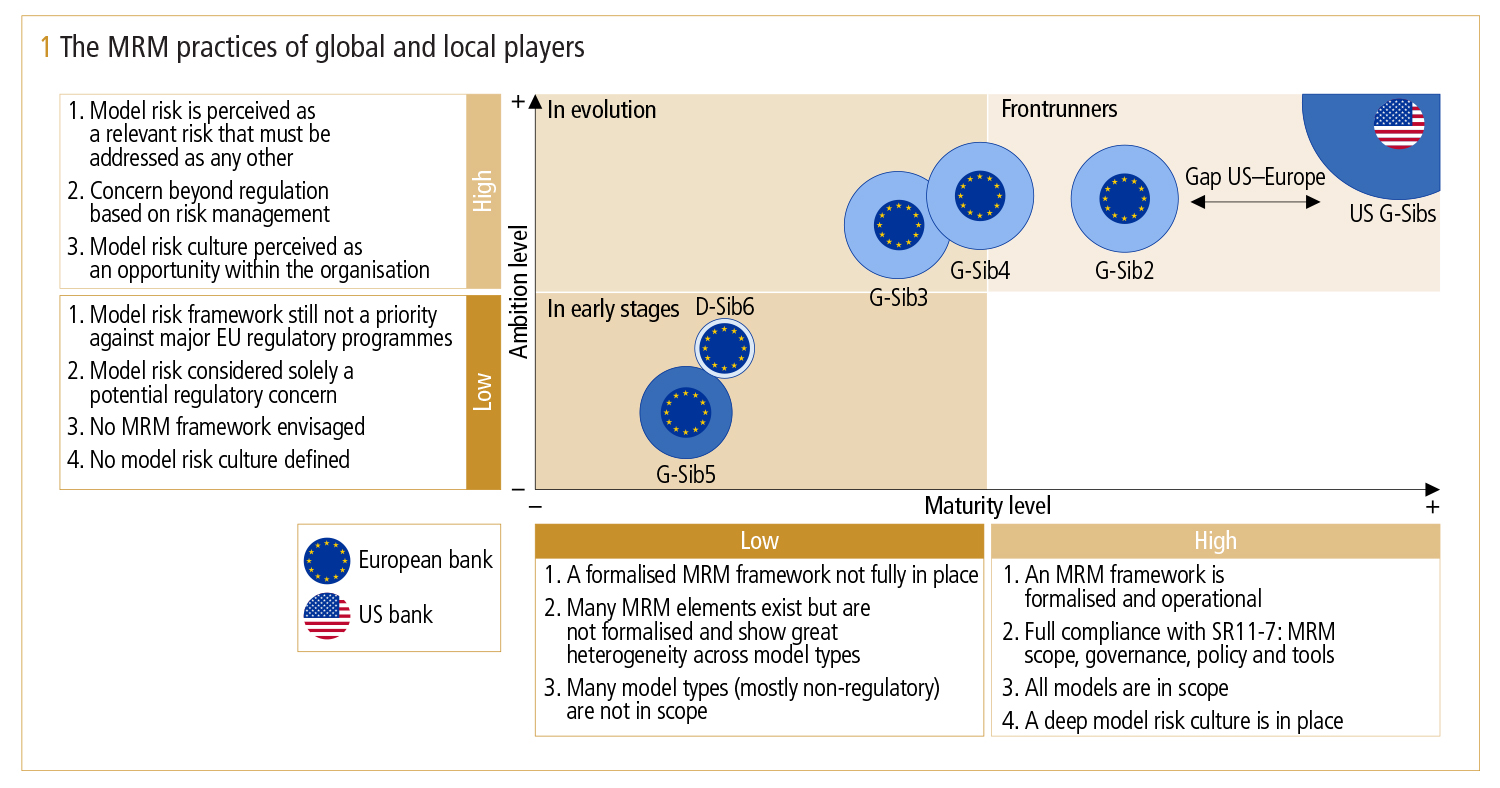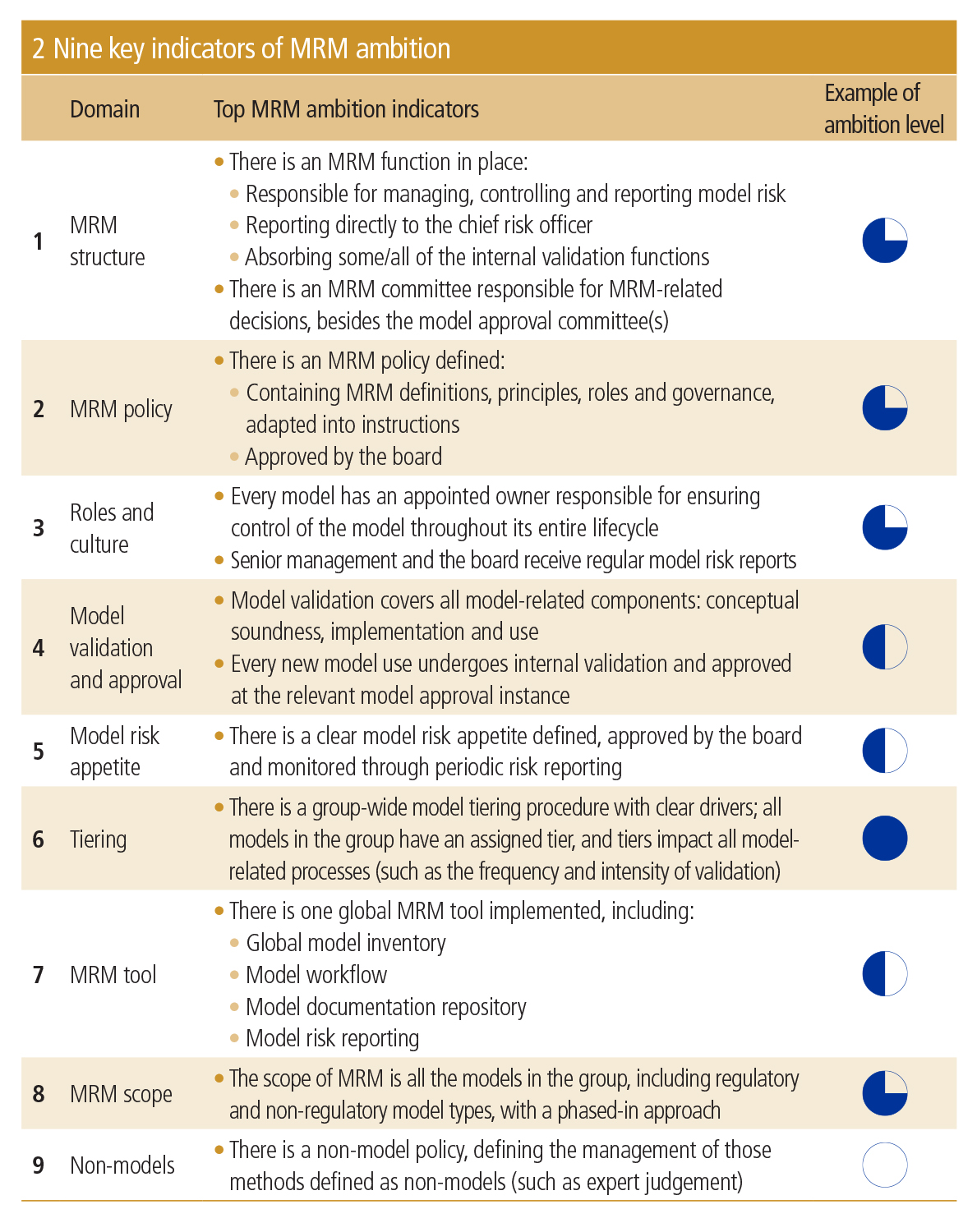
This article was paid for by a contributing third party.More Information.

Converging on sound model risk management practices

Although most banks are progressing rapidly towards a certain standard in model risk management (MRM) practices, the rate of progress is uneven and so are the ambition levels. Management Solutions provides a summarised overview of the state of MRM evolution and how banks are striving to converge
When it comes to the level of maturity of MRM frameworks, a distinction can be made between at least three tiers of banks (see figure 1).

First, there are most major US banks, which have been subject to the US Board of Governors of the Federal Reserve System and Office of the Comptroller of the Currency’s Supervisory guidance on model risk management (SR 11-7) for nearly eight years, and have been under major pressure to develop their MRM frameworks. This group’s distinctive feature is their success in conceiving model risk as a concern beyond regulation. Their focus is to safeguard the bank, not merely to comply with regulation, although one leads to the other.
A second tier comprises major non‑US banks with a significant presence in the US. They have also experienced the pressure to adapt to SR 11‑7, but only in their US branches. They are bringing that experience upstream to their holding company and to other relevant subsidiaries. Even though their level of maturity is still behind their US peers – for example, their MRM scope tends to focus only on regulatory models – these banks are making rapid progress.
A third tier consists of all other banks, including medium-sized ones and major institutions that have prioritised other initiatives. Indeed, they are struggling with a tsunami of model-related regulatory requests – the Targeted Review of Internal Models (Trim), Fundamental Review of the Trading Book, International Financial Reporting Standard 9, new definition of default, and so on – and, since resources are limited, they have concentrated efforts on responding to these requests.
It is noteworthy that not all banks actually want to be on the exact same level of maturity regarding MRM. Indeed, with varying levels of regulatory pressure, organisational complexity and internal concern around model risk, the concept of ambition level regarding MRM becomes all the more important.
To this extent, with model risk being so transversal and MRM such a multidimensional activity, decision-making at a bank’s desired level of ambition becomes a challenging task in itself. For that purpose, it may prove useful to have a set of MRM ambition indicators – for example, on MRM structure, policies, appetite – to determine how the bank relates to them (see figure 2). This is a high-level self-assessment tool, which is then adapted into a number of detailed statements that may be useful to periodically measure the level of evolution against an objective yardstick.

Finally, it is worth noting how banks are facing different challenges in their evolution towards a sound MRM framework, varying for the most part according to two axes: geographic footprint – and the applicable regulation – and size. Focusing on the latter, large institutions are concentrating efforts on ensuring consistent deployment of their MRM frameworks across countries and subsidiaries, appointing and empowering model owners, and fostering a model risk culture. Medium-sized institutions, meanwhile, are struggling to obtain sponsorship and the involvement of senior management despite reduced regulatory pressure. Additional challenges include inventorying all models in use or even defining what a model is.
Over the past few years, Management Solutions has observed a very positive increase in banks’ awareness of model risk, which is rapidly translating into structured MRM frameworks. Although convergence is still distant and, to some degree, hampered by the heterogeneity of regulation across countries, the influence of SR 11‑7, the European Central Bank’s Trim project – which is already issuing findings on MRM through Pillar 2 – and US and European Union industry best practices seem to be leading the way for institutions worldwide.
Model risk management – Special report 2019
Read more
Sponsored content
Copyright Infopro Digital Limited. All rights reserved.
You may share this content using our article tools. Printing this content is for the sole use of the Authorised User (named subscriber), as outlined in our terms and conditions - https://www.infopro-insight.com/terms-conditions/insight-subscriptions/
If you would like to purchase additional rights please email info@risk.net
Copyright Infopro Digital Limited. All rights reserved.
You may share this content using our article tools. Copying this content is for the sole use of the Authorised User (named subscriber), as outlined in our terms and conditions - https://www.infopro-insight.com/terms-conditions/insight-subscriptions/
If you would like to purchase additional rights please email info@risk.net